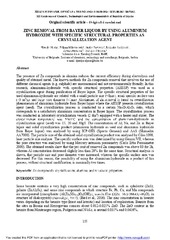| dc.creator | Oljača, Đurđa | |
| dc.creator | Milovanović, Biljana | |
| dc.creator | Pavlović, Stefan | |
| dc.creator | Smiljanić, Radenko | |
| dc.creator | Obrenović, Zoran | |
| dc.creator | Filipović, Radislav | |
| dc.date.accessioned | 2020-11-18T16:09:33Z | |
| dc.date.available | 2020-11-18T16:09:33Z | |
| dc.date.issued | 2018 | |
| dc.identifier.uri | https://cer.ihtm.bg.ac.rs/handle/123456789/3771 | |
| dc.description.abstract | The presence of Zn compounds in alumina reduces the current efficiency during electrolysis and quality of obtained metal. The known methods for Zn compounds removal that involves the use of different chemical agents (e.g. sulphide) are uneconomical and not environmentally friendly. In this research, aluminium-hydroxide with specific structural properties (AHSSP) was used as a crystallization agent during purification of Bayer liquor. The specific structural properties of the used aluminium-hydroxide are related with a small particle size (<8μm), small specific surface area (≈3 m2/g), and large pore diameter (≈1μm). Mechanism of Zn removal is based on crystallization phenomenon of aluminium-hydroxide from Bayer liquor where the AHSSP presents crystallization agent (seed). The crystallization process is conducted to a certain Na2O/Al2O3 ratio, which corresponds to a satisfactory aluminium concentration in Bayer liquor. The crystallization process was conducted in laboratory crystallization vessels (2 dm3) equipped with a heater and stirrer. The crystallization temperature was 50±1°C and the concentration of aluminium-hydroxide as crystallization agent (seed) was 15, 20 and 30g/l. The concentration of Al, Na, and Zn in Bayer liquor and solid crystallization product (aluminium hydroxide as seed and aluminium hydroxide from Bayer liquor) was analysed by using ICP-OES (Specto Genesis) and AAS (Shimadzu AA7000). The particle size of the obtained solid crystallization product was analysed by Cilas 1090, laser particle size analyser. The specific surface area was determined by using Gemini VII, whereas the pore structure was analysed by using Mercury intrusion porosimetry (Carlo Erba Porosimeter 2000). The obtained results show that the per cent of removed Zn compounds was above 80 for 2h, whereas Al concentration decreased slightly less than 20% for the same time. Structural analysis is shown, that particle size and pore diameter were increased, whereas the specific surface area was decreased. For this reason, the possibility of using the aluminium-hydroxide as a product of this process, without structural modification, is maximally two times. Keywords: Zn-compounds, crystallization, alumina, and structural properties. | en |
| dc.language.iso | en | sr |
| dc.publisher | Association of Technology Engineers of Republic of Srpska | sr |
| dc.rights | openAccess | sr |
| dc.rights.uri | https://creativecommons.org/licenses/by/4.0/ | |
| dc.source | Proceedings - XII Conference of Chemists, Technologists and Environmentalists of Republic of Srpska | sr |
| dc.subject | Zn-compounds | sr |
| dc.subject | crystalization | sr |
| dc.subject | alumina | sr |
| dc.subject | Structural properties | sr |
| dc.title | Zinc removal from Bayer liquor by using aluminium hydroxide with specific structural properties as crystallization agent | en |
| dc.type | conferenceObject | sr |
| dc.rights.license | BY | sr |
| dcterms.abstract | Смиљанић, Раденко; Миловановић, Биљана; Ољача, Ђурђа; Павловић, Стефан; Филиповић, Радислав; Обреновић, Зоран; | |
| dc.citation.spage | 155 | |
| dc.citation.epage | 158 | |
| dc.identifier.rcub | https://hdl.handle.net/21.15107/rcub_cer_3771 | |
| dc.identifier.fulltext | https://cer.ihtm.bg.ac.rs/bitstream/id/17635/Zinc_removal.pdf | |
| dc.type.version | publishedVersion | sr |


